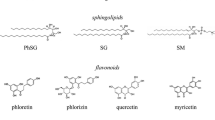Summary
(Photo-)redox reactions of different amphiphilic flavins bound to artificial membrane vesicles made from three different, saturated phospholipids have been investigated and compared with those of isotropically dissolved flavin. By means of C18-hydrocarbon chains, substituted at different positions, the flavin nucleus can be specifically oriented within the membrane, thereby imposing sterically anisotropic environments, which are liable to control flavin (photo-) chemistry. A spectrophotometric setup was designed, permitting photoreduction of flavin and its simultaneous control by fluorescence. The characteristic temperature dependency of the (vesicle-bound) flavin photoreduction by external and internal photosubstrates, as studied for the different lipid/flavin systems, is explained by the displacement of the flavin nucleus from the area of the polar head groups of the lipid into the more hydrophobic parts of the membrane upon phase transition (gel→liquid crystalline). Evidence is presented that this flavin displacement is correlated with the pre-phase transition rather than with the main phase transition, supporting a former hypothesis of the structural nature of the pre-phase transitions. The transport of redox equivalents across flavin-charged membranes is discussed. The accessibility of vesicle-bound flavins by a variety of exogeneous ions (H+, Cs+, EDTA, NTA, BH3CN−, I−, N −3 ) is explored as a function of temperature, i.e., membrane phase which, in turn, appears to control the permeability of the lipid/water interface. Therefore, it appears indispensable to include the interface as a separate structural entity into any theory on membrane transport.
Similar content being viewed by others
References
Blumenthal, R., Changeux, J.-P., Lefever, R. 1970. Membrane excitability and dissipative instabilities.J. Membrane Biol. 2:351
Bruice, R.C. 1976. Models and flavin catalysis.In: Progress in Bioanorganic Chemistry. E.T. Kaiser and F.J. Kezdy, editors. Vol. 4, p. 1. John Wiley & Sons, New York-London-Sidney-Toronto
Butler, W.L. 1972. Spectroscopy of biological materials.In: Methods in Enzymology. Vol. XXIV, Part B, pp. 3–25. A. San Pietro, editor. Academic Press, New York
Butler, W.L., Hopkins, D.W. 1970. Higher derivative analysis of complex absorption spectra.Photochem. Photobiol. 12:439
Ghisla, S., Hartmann, W., Hemmerich, P., Müller, R. 1973. Die reduktive Alkylierung des Flavinkerns; Struktur und Reaktivität von Dihydroflavinen.Liebigs Ann. Chem. 1973:1388
Gibson, Q.H., Hastings, J.W. 1961. The oxidation of reduced flavin mononucleotide by molecular oxygen.Biochem. J. 83:368
Haas, W., Hemmerich, P. 1979. Flavin-dependent substrate photo-oxidation as a chemical model of dehydrogenase action.Biochem. J. 181:95
Heelis, P.F., Parsons, B.J., Phillips, G.O., Barghigiani, C., Colembetti, G., Lenci, F., McKellar, J.F. 1979. Flavin pigments embedded in lipid matrices: A spectroscopic and photochemical investigation.Photochem. Photobiol. 30:507
Hemmerich, P. 1976. The present status of flavin and flavoenzyme chemistry.Prog. Chem. Org. Natural Prod. 33:451
Hemmerich, P. 1977. Bio(in)organic views on flavin-dependent one-electron transfer.In: Bioorganic Chemistry II. pp. 321–329, Advances in Chemistrys, Series No. 162. K.N. Raymond, editor. Academic Press, New York
Hemmerich, P., Ehrenberg, A., Walker, W.H., Erikson, L.E.G., Salach, J., Bader, P., Singer T.P. 1969. On the structure of succinate dehydrogenase flavocoenzyme.FEBS Lett. 3:37
Hemmerich, P., Knappe, W.-R., Kramer, H.E.A., Traber, R. 1980. Distinction of 2e − and 1e − reduction modes of the flavin chromophore as studied by flash photolysis.Eur. J. Biochem. 104:511
Hemmerich, P., Massey, V. 1980. The role of the apoprotein in directing pathways of flavin catalysis.In: Oxidases and Related Redox Systems. T.E. King, H.S. Mason, M. Morrision, editors, Pergamon Press, Oxford (in press)
Hemmerich, P., Wessiak, A. 1979. On the chemistry of flavin-dependent oxygen activation.In: Oxygen: Biochemical and Clinical Aspects. W.S. Caughey, editor. pp. 491–511. Academic Press, New York
Hinz, H.J., Sturtevant, J.M. 1972. Calorimetric studies of dilute aqueous suspensions of bilayers from syntheticl-α-Lecithin.J. Biol. Chem. 247(19):6071
Kavanagh, R., Goodwin, R.H. 1949. The relationship between pH and fluorescence of several organic compounds.Arch. Biochem. 20:315
Klibanov, A.M., Kaplan, N.O., Kamen, M.D. 1978. A rationale for stabilizing of oxygen-labile enzymes: Application to a clostridial hydrogenase.Proc. Natl. Acad. Sci. USA 75:3640
Ladbrooke, B.D., Chapman, D. 1969. Thermal analysis of lipids, proteins and biological membranes; A review and summary of recent studies.Chem. Phys. Lipids 3:304
Lee, A.G. 1975. Functional properties of biological membranes: A physical chemical approach.Prog. Biophys. Mol. Biol. 29:5
Lipson, E.D., Presti, D. 1977. Light-induced absorbance changes inPhysomyces photomutants.Photochem. Photobiol. 25:203
Michel, H., Hemmerich, P. 1980. Substitution of the flavin chromophore with lipophilic sidechains: A novel membrane redox label.J. Membrane Biol. 60:143
Radda, G.K., Calvin, M. 1964. Chemical and photochemical reductions of flavin nucleotides and analogs.Biochemistry 3:384
Schmidt, W. 1979. On the environment and the rotational motion of amphiphilic flavins in artificial membrane vesicles as studied by fluorescence.J. Membrane Biol. 47:1
Schmidt, W. 1980. Physiological bluelight reception.In: Structure and Bonding. P. Hemmerich, editor. Vol. 41, pp. 1–41. Springer, Berlin-Heidelberg-New York
Schmidt, W. 1980. A high-performance dual wavelength spectrophotometer and fluorometer.J. Biochem. Biophys. Methods 2:171
Schmidt, W., Butler, W.L. 1976. Flavin-mediated photoreactions in artificial systems: A possible model for the bluelight photoreceptor pigment in living systems.Photochem. Photobiol. 24:71
Träuble, H. 1971. Phasenumwandlungen in Lipiden, Mögliche Schaltprozesse in biologischen Membranen. Naturwissenschaften58:277
Trissl, H.W. 1974. Studies on the incorporation of fluorescent pigments into bilayer membranes.Biochim. Biophys. Acta 367:326
Walker, W.H., Hemmerich, P., Massey, V. 1970. Light-induced alkylation and dealkylation of the flavin nucleus. Stable dihydroflavins. Spectral course and mechanism of formation.Eur. J. Biochem. 13:258
Weber, G. 1954. Dependence of the polarization of the fluorescence on the concentration.Trans. Faraday Soc. 50:552
Author information
Authors and Affiliations
Rights and permissions
About this article
Cite this article
Schmidt, W., Hemmerich, P. On the redox reactions and accessibility of amphiphilic flavins in artificial membrane vesicles. J. Membrain Biol. 60, 129–141 (1981). https://doi.org/10.1007/BF01870415
Received:
Revised:
Issue Date:
DOI: https://doi.org/10.1007/BF01870415



